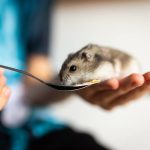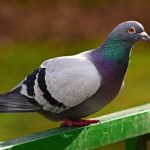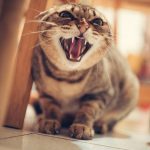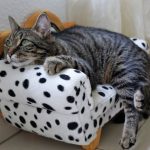Quick Navigation
Did you know that kittens gain 1 pound per month?
It is easy to monitor our feline babies’ well-being by watching their growth and development patterns.
Physically, cats grow most rapidly when they are kittens. On average, they gain 1 pound a month between birth and six months of age.
Once they reach maturity, their growth rate drastically reduces.
Cats stop growing between 12 and 16 months. At this point, most adult cats weigh approximately 10 pounds.

Some cat breeds, such as the Maine Coon, continue to grow to age 5fiveand weigh 25 pounds.
After physical development stops, feline mental development continues consistently into the older years of every cat.
Like people, cats vary in size, and feline growth charts provide guidelines on how quickly our cats should develop.
Naturally, according to genetic factors and nutrient intakes, there are smaller and larger cats across different breeds or single species.
On the other hand, a smaller cat’s body structure may be caused by health problems or dwarfism.
These health problems are not life-threatening and can be easily managed or treated.
Is it Normal For A Cat To Be Small?
Because of the breed type, it is perfectly normal for some species of cats to be small naturally.
However, as a cat owner, before you conclude that your cat is naturally small, you should look into your cat’s ancestry and analyze whether it is part of a small-sized breed. If it is, you have nothing to worry about.
Additionally, if your cat is small-size, it might be a sign of a serious illness your cat is fighting, making it become thinner and experience stunted growth.
In this case, a vet consultation would help determine the sickness causing your cat to be small, its cause, and its cure.
6 Reasons Why Your Cat Is Small For Its Age
There’s no need to worry if your cat has a small body, a visit to a veterinarian can you help rule out any medical issues.
Extra attention and care may be required for small-body-size cats, especially kittens.
Below are 6 of the most common reasons why some cats are small for their age.
1. The Smallest of the kittens
It is typical to have a more petite kitten with a much lower birth weight than its siblings in every litter of kittens.
This kitten is called the runt of the trash.
Kittens attached to placentas with little nutrient supplies develop poorly in the womb and are born small.
Each kitten has its placenta in the womb, and some placentas are closer to the source of nourishment than others.
Accordingly, these are attached to the nourishment center, receive more nutrients than others, and develop well.
As per the care given to kittens, most runts catch up in size after birth, but some stay small.
This growth pattern is usually associated with fetal developmental issues caused by low nutrient intake in the womb.
For instance, runts are characterized by underdeveloped organs: deformations, and weak bones.
What’s Important To Know
It is normal for mother cats to reject runts because she thinks they will die.
Human intervention, therefore, is necessary to provide runts with adequate food and care.
For runts, food must be provided every 2 hours.
You can also assist a runt in latching to its mother’s teat or feeding it with kitten milk replacement formula.
Runts must be kept warm and clean, as cats are most vulnerable to hypothermia and infections when they are young.
When they are very young, runts need assistance with toileting.
Runts must also be shown affection by cuddling and petting them often.
It is important to note that a mother cat stimulates her kittens to urinate by licking.
However, if she rejects a runt kitten, a moist wipe can be used to rub the area and stimulate urination.
2. Cat Breed
Did you know that there are over 100 domestic cat breeds globally?
Different cat breeds have different genetics that significantly influences their sizes.
Most domestic cats have similar dimensions. The adults typically weigh around 10 pounds and are about 18 inches long (excluding their tails).
However, some breeds are significantly more significant, and others are smaller.
For example, the Singapura cat is often called the smallest cat breed in the world.
Smaller cat breeds tend to have shorter developmental stages than other normal cats.
What’s Important To Know
It is crucial to understand that it’s very typical for kittens from the same litter to have different fathers.
Queens are promiscuous when in heat, and multiple fertilisations from different toms are common.
Therefore you should stop comparing your cat’s size to its siblings. It may be a runt, as explained above, or it might be of a different breed.
The most important thing is to visit a vet who will help you examine whether your kitten is a runt or it is the breed of the cat.
3. Cat Sex And Fixed Cats
The Puberty stage slows growth in cats, and feline bones continue to grow for extended periods when it is prevented.
Male cats generally grow larger than females of the same breed.
Additionally, spaying females and castrated male cats alter their growth and development, overgrowing.
Cats that are fixed before they mature tend to grow more extensively than those set left to grow naturally.
What’s Important To Know
Timing is essential when it comes to fixing cats. If you have a cat restored after it reaches puberty, that may explain its small size.
Nonetheless, the bigger sizes of cats that are fixed early do not automatically make them better.
The extended period of bone development puts them at a higher risk of bone fractures.
4. Dwarf Cats, Miniature Cats, And Teacup Cats
Genetic mutations affect cats leading to stunted growth.
The condition is caused by a genetic defect that results in the development of disproportional adult cats.
Dwarfism is rare in cats, and the Munchkin cat is often considered the original breed of dwarf cats.
Munchkin cats have normal-sized bodies, big heads, and abnormally short limbs.
Also, they often develop health issues, including deformed limbs, undersized jaws, and curved spines.
Apart from that, heart, lung, and neurological problems are also common in this breed.
Additionally, dwarf cats have restricted mobility, which makes them highly prone to developing obesity.
Miniature and teacup cats are undersized for their age but have normal body proportions.
Their main physical difference is that teacups are smaller than miniature cats.
Miniature cats have genetic defects that cause them to be about one-third to one-half the size of cats of the same breed.
Teacup cats are born with dwarfism that affects not only their limbs but also their entire bodies.
They are about two-thirds the size of average adult cats.
Teacup cats can have medical issues such as soft bones, enlarged hearts, bowed legs, and abnormal reproductive organs.
What’s Important To Know
Most dwarf, miniature, and teacup cats are bred selectively and sold at high prices.
Breeders take advantage of the genetic mutations to create breeding lines where the small-size genetic trait is continually recurring.
The ethics of selective breeding are debated globally because of the health issues associated with many dwarf cats.
Additionally, even if you do not purchase a cat bred to be minor, it is possible to end up with one.
The genetic mutations that lead to dwarfism or miniaturization can still occur when “normal” cats mate.
Dwarfism occurs when inbreeding happens between similar cats over multiple generations.
5. Malnourishment
If cats do not receive adequate nourishment, they develop slowly
Your cat may be small for its age due to poor nutrition.
Stunted growth, in particular, can occur if cats do not receive enough vitamin B6 and pantothenic acid.
Long-term malnutrition causes chronic cat diseases, including osteoporosis, heart disease, and kidney disease.
A variety of things that can cause malnutrition in cats are:
- Owners are not feeding cats well or providing an unbalanced diet. Malnutrition is more common in cats that are solely fed on dry food diets. They can be supplemented with inexpensive homemade broths or stocks to improve nutrient content.
- Hereditary conditions that cause malabsorption. This condition is the inability to absorb one or more nutrients from a diet.
- Picky cats that do not eat the food they are provided.
- Other pets or animals are consuming their food.
What’s Important To Know
Cats must be provided with wholesome diets, following veterinary guidelines.
Specialized diets may be required, and kittens must only be fed with either their mother’s milk or formula.
If your cat is not nourishing enough, you can monitor it when it eats to check that they consume enough food and other animals do not eat their food.
6. Worm Infestations
Intestinal parasites can also impair growth in cats.
The most common parasitic worms include tapeworms, roundworms, and hookworms.
This infestation is observed more in kittens as infections tend to overwhelm them.
They live in feline intestines and either feed on nutrients from the diet or on the blood of infected cats.
What’s Important To Know
Veterinarians can diagnose and treat worm infestations with immediate effect.
If your cat is small and you do not know why it is advised to take them for a check-up.
Worm infections occur commonly in cats and can majorly cause small cat sizes.
Additionally, they can be passed on quickly to other pets or people, and the infections can be life-threatening in kittens.
Small Cats Have Their Advantages
Most small cats are perfectly healthy and live just as long as ordinary-sized cats.
However, if you are concerned about your cat being small for its age, go to a veterinarian to identify any health issues.
Smaller cats also have their advantages.
They are ideal for small living spaces, adorable to look at, and easy to cuddle.
Their vocalizations are softer than those of more giant cats, and they cause less damage when they claw at furniture.
Additionally, when cats are small because of health conditions, it does not make them substandard.
Always provide extra care for smaller cats, especially runts, to keep them as healthy as possible.

Purrfect n’ Pawesome is the brainchild of Amanda, who has been into researching and writing about pets to help other pet parents in nurturing their adorable pets. Currently, she runs Purrfect n’ Pawesome along with her team of experienced and dedicated pet experts. Along with being an awesome writer and entrepreneur, Amanda is a cat mom to two innocently spoiled cats, Balanca and Scruffy.
She has been writing about pet care and nurturing and wants to share her readers’ experiences, learnings, and knowledge.
Over the years, she had the opportunity to work with various pet owners having multiple breeds, and that exposure gave her experience and the lessons of a lifetime.
Her family, her entire universe revolves around her two cats, who give her endless support and inspiration to move ahead with her objectives in life. Amanda is a live example of a balanced approach to all parenthood questions we all face in life.




![Why Do Ferrets Smell? [All Reasons Explained!] Why Do Ferrets Smell? [All Reasons Explained!]](https://purrfectnpawesome.com/wp-content/uploads/2021/02/Reasons-Ferrets-Smell-150x150.jpg)

